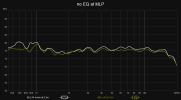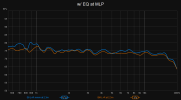ernestcarl
Major Contributor
I guess the question I have is that I have 10 or so quasi-anechoic measurements per speaker (one for every 10 degrees), and only one MMM per speaker. So what should then correspond with what?
Make your own quasi-anechoic listening window (LW) curve and use that overlayed on top of your MMM curve. This helps prevent you from over-equalizing above the transition zone or Schroeder freq. of the room. My own LW curve is made up of the rms avg of a select combination of horizontal (0-30 degrees left and right) and vertical (0-22.5 degrees up and down) group/family of curves .
From trace #1, my moving microphone measurement/method (MMM) indicate that I should apply more EQ cuts below 1 kHz. BUT, my very nearfield quasi-anechoic curves say otherwise -- speakers are point-source coaxes making it somewhat easy to make very nearfield quasi-anechoic measurements in-room. The necessary placement of the speakers inside the room (very close to numerous boundaries causing unwanted interferences/reflections) makes equalizing in between the transition zone very tricky. Relying on multiple references -- again, use 'Overlays' view window/tab in REW -- helps one to avoid applying excessive and unnecessary EQ corrections.


